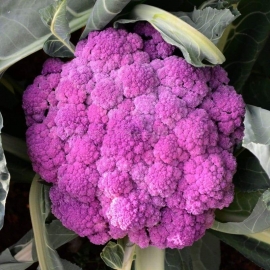
«Purple Sicily» - Organic Cauliflower Seeds
1.14 €
Purple Sicily Cauliflower grows in the cooler seasons as a biennial cruciferous vegetable. By its scientific name, Brassica oleracea var. botrytis, it is known to belong to the plant order Capparales.
-
Organic Cauliflower «Purple Sicily»
Purple Sicily Cauliflower grows in the cooler seasons as a biennial cruciferous vegetable. By its scientific name, Brassica oleracea var. botrytis, it is known to belong to the plant order Capparales.
Unlike white cauliflower, this cauliflower's color comes from the antioxidant anthocyanin, which is also present in red cabbage.
These are a culinary delight, and the heads cook to bright green. While the insect-resistant varieties tend to be easier to grow than many white varieties; all varieteies are rich in minerals and look beautiful in any vegetable garden bed. These crops display lush violet shades on the outside florets, but stems remain mundane at the core of the vegetable, retaining a cream color.
Although one wouldn't know by the color, Purple Sicily is a treat to eat and all parts (floret, stalk and leaves) are edible. While the stems and trunk are harder, the florets have a unique flavor. Overall, this cauliflower has a flavor that is milder, sweeter, nuttier and less bitter than that of the white cauliflower.
Sow
Sow thinly, 2cm (¾in) deep in a seedbed. Final rows should be 15cm (6in) apart for mini caulis or around 60cm (24in) for larger cultivars. Thin the seedlings to a final spacing of 15cm (6in) apart for mini caulis or 60cm (24in) for larger cultivars. However, best results come from sowing in cell trays using any good multi-purpose potting compost. As cauliflowers mature in a rush, avoid raising too many plants at a time.
The main sowing period is March to May, although early crops can be achieved by sowing under glass in January/February or sowing cultivars in the autumn in a glasshouse or coldframe.
Grow
Cauliflowers do best in very fertile soil, and digging in a bucketful of well-rotted manure or organic matter before planting, and raking in 150g per sq m (5oz per sq yd) of Growmore or other general purpose fertiliser, will help growth. Firm the soil by treading before planting.
If growth is checked, at any time during growth, they produce small, deformed heads. To avoid problems, water plants well the day before transplanting and make a hole deep enough to hold the plant with the lowest leaves at ground level. Fill this hole repeatedly with water. This will fill the hole with soil and ensure the plant is sitting in a large area of moist soil. Firm the soil very well against the roots.
Space summer and autumn cropping types 60cm (2ft) apart and winter cultivars around 75cm (2.5ft) apart; spacing of 30-45cm (12-18in) apart, provides mini, 'one person' curds. Water well in dry weather, watering every 10 days, and apply sufficient water to thoroughly wet the root zone. Once the plants are growing well, add 30g (1oz) per square metre of high nitrogen fertiliser such as sulphate of ammonia to boost growth and curd formation.
Harvesting
Start cutting when the heads are firm; once the florets start to separate, it is too late.
